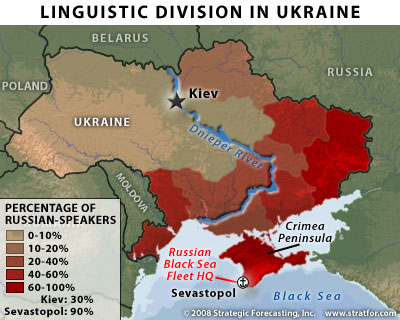Ukraine Military Helicopter Shot Down as Battles Flare in the East

Rebel fighters in the city of Slavyansk shot down a Ukrainian military helicopter Thursday, killing 14 soldiers, including an army general, according to press reports from eastern Ukraine that were confirmed by government officials in Kiev.
Acting president Oleksandr Turchynov told parliament that a shoulder-launched air defense missile was used to shoot down the Mi-8 helicopter. It was ferrying troops into the outskirts of Slavyansk, a stronghold for pro-Russian separatists opposed to the fascist-backed government in Kiev.
The general killed was identified as Maj. Gen. Vladimir Kulchytsky, a former officer in the Soviet military who was in charge of combat training for Ukraine’s National Guard. The National Guard has become the vehicle for the mobilization of fascist and ultra-nationalist gunmen against the population of Ukraine, drawing new recruits from the Right Sector and the Svoboda (Freedom) party, two groups that hark back to the pro-Hitler Ukrainian nationalists of the World War II era.
Six of the dead were members of the National Guard, while the other eight were from a special forces unit of the Interior Ministry—all evidently picked for their willingness to go into combat against their own people.
Turchynov described those who shot down the helicopter as “terrorists” and “criminals,” the terms used by the Kiev regime to describe all its political opponents in eastern and southern Ukraine. He claimed that air strikes and artillery strikes had destroyed the insurgent unit responsible for shooting down the aircraft.
Addressing the parliament, Turchynov threatened sweeping military vengeance against those who resisted Kiev’s dictates. “Our armed forces, our security forces will complete their job against terrorism,” he said. “And all the criminals who are now funded by the Russian Federation will be destroyed or sit in the dock.”
Press reports spoke of heavy fighting around Slavyansk, including artillery bombardments of residential neighborhoods in the city—a true act of terrorism, perpetrated by the government forces. There were no confirmed reports of casualties on either side, behind the death toll from the helicopter shoot-down.
The Associated Press quoted one resident, Olga Mikailova, who said she was leaving the city for her family’s safety. “They are shooting at us from grenade launchers. We hear explosions. The windows of our house are shaking,” she said. “I have four children. It is terrifying being here, because I am afraid for their lives.” USA Today cited comments from Olga Oliker, an analyst at Rand Corp. familiar with the capabilities of the Ukrainian army. She said that it lacked the ability to gather intelligence, conduct precision strikes and avoid civilian casualties, concluding with the remarkably open admission, “They are fighting a domestic population.”
The Russian broadcast NTV reported popular opposition to the intensified warfare in the east, expressed in the actions of parents of conscripts who went to the Ukrainian Interior Ministry base in the Luhansk region to take their sons home.
In Donetsk, the capital of the eastern region, funerals were taking place for many of those killed in fighting near Sergei Prokofiev airport just outside the city. After separatist fighters seized control of the airport, the Ukrainian regime called in airstrikes, incinerating as many as 50 people, including both local residents and volunteers who had crossed the border from Russia, a few miles away.
Billionaire chocolate magnate Petro Poroshenko, who won the gunpoint election held Sunday in the government-controlled portions of Ukraine, hailed the bloodbath in Donetsk, declaring the fight to reestablish Kiev’s control over the eastern region “has finally really begun.”
Poroshenko’s comments were echoed by US President Obama in his commencement speech at the US Military Academy Wednesday, where he announced that he had spoken to the incoming Ukrainian president and condemned what he called “armed militias in ski masks”—not the fascist thugs who spearheaded the overthrow of Yanukovych, but the people of eastern Ukraine opposed to the ultra-right regime in Kiev.
The US-backed regime has now set June 7 for Poroshenko’s inauguration, although there will be no significant change in either the policy or the personnel in control in Kiev. Poroshenko said he would keep Arseniy Yatsenyuk as premier, while delaying any parliamentary election until the end of the year.
The Party of Regions, the organization previously headed by the ousted President Viktor Yanukovych, has a plurality in the current parliament, although many of its legislators have stayed away from Kiev for fear of violence by Right Sector and Svoboda thugs.
In an interview Wednesday with Germany’s Bild newspaper, Poroshenko said that he would ask the US government for military supplies and training. It is not clear where this training would take place, raising the possibility of stationing US “advisers” on Ukrainian soil.
Poroshenko issued a statement Thursday saying he would sign an economic agreement with the European Union as soon as he takes office next week. Yanukovych’s balking at such an agreement—which includes drastic austerity measures that will devastate the Ukrainian economy and drive up unemployment—was the occasion for the US-backed drive to remove him from office.
“The signing and enactment of the agreement … is part of Ukraine’s modernization plan,” Poroshenko said, adding that he hoped to “implement the reforms package within a very short period of time.”
He also said that he would hold talks with Russian President Vladimir Putin in July. Russia has effectively halted all support to the separatist forces in the east and recognized Poroshenko’s election. As the fighting in the east flared, Putin travelled to Central Asia Thursday, signing an economic agreement to establish a “Eurasian Union” with Kazakhstan and Belarus.

